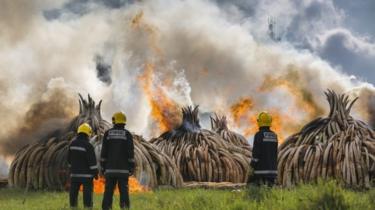http://mobile.nytimes.com/2016/05/0....html?smid=fb-nytimes&smtyp=cur&_r=0&referer=


NAIROBI, Kenya What do you do when you have more than $100 million worth of ivory sitting around, just collecting dust?
You burn it, of course.
That is what Kenya did on Saturday, when President Uhuru Kenyatta lit a huge pyre of elephant tusks as a way to show the world that Kenya is serious about ending the illegal ivory trade, which is threatening to push wild elephants to extinction.
No one, and I repeat, no one, has any business in trading in ivory, for this trade means death the death of our elephants and the death of our natural heritage, Mr. Kenyatta said.
In the past few years, heavily armed poachers, using military tactics, have wiped out tens of thousands of elephants across Africa. Many of the tusks enter an underground pipeline to Asia, especially China, where ivory is used to make eyeglass frames, combs, statuettes and other trinkets.
Wildlife experts say the street price of a kilogram of ivory is around $1,000. On Saturday, Kenya set alight 105 metric tons of ivory its stockpile of confiscated and recovered tusks. It was the most ivory ever destroyed at one time, representing 6,000 to 7,000 dead elephants.
At current prices, and without including the rhino horns also burned, that is a $105 million bonfire.
Richard Leakey, one of Kenyas leading conservationists, said he was humbled, sad and encouraged.
We shouldnt have to burn 105 tons of ivory and 1.5 tons of rhino horn, he said. It is a disgraceful shame this continues.
This was not the first time that truckloads of tusks had been burned. Mr. Leakey presided over a large ivory bonfire in Kenya in 1989. Since then, many other countries have done the same to make the statement that ivory is worthless unless it is on an elephant.

